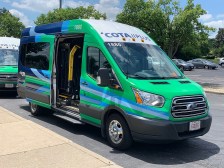West Sacramento launches citywide microtransit pilot

The city of West Sacramento launched a yearlong citywide microtransit pilot this week that Mayor Christopher Cabaldon is calling “the lovechild between Uber, Lyft and the bus.”
West Sacramento, which opened the pilot with a fleet of 10 six-passenger Mercedes vans on Monday, is one of a handful of cities throughout the U.S. experimenting with microtransit in response to the strain that ride-sharing services have put on the finances of traditional mass transit systems like buses and trains. In its pilot, West Sacramento partnered with Via, a New York City-based microtransit company that partners with cities around the world and also operates its service independently in some places. While its still unclear whether microtransit will be sustainable in the long term, Cabaldon told StateScoop he thinks it could allow the city to pare down some of its low-productivity bus routes.
“So instead of running a 45-seat bus around the suburbs, spidering through every cul-de-sac looking for one rider an hour, the money we’re spending on that we’ll be able to use and provide many, many, many more rides,” Cabaldon said. “In a stroke of evolution, we’ll be able to strengthen the bus lines that really make sense and be able to eliminate the ones that don’t.”
For a flat fee of $3.50 (or $1.75 for seniors), anyone can hail a van from anywhere in the city, by smartphone app or regular phone call. The vans don’t go exactly where riders want, like an Uber or Lyft does, but will drop passengers off within a block or a block and a half at the most, Cabaldon said.
The city has partnered with its local transit agency to ensure the service is being used in the most effective way, and the city also partnered with the University of California, Berkeley to examine the data generated by the pilot.
“We’re being clear-eyed about this,” Cabaldon said, adding that he doesn’t know if it will be sustainable, but says that it will be valuable because the service reaches everywhere — “some of the most isolated areas, the poorest areas, and the suburbs, which are notoriously impossible to serve with transit effectively.”
Via says on its website that it has provided more than 30 million rides globally. In some cities, it partners with local government and in others it operates independently. Microtransit has seen success in some areas, while some pilots have failed to strike a balance between cost and passenger volume. Now-defunct microtransit startup Bridj partnered with Kansas City, Missouri’s transit authority on a six-month pilot in 2015 before shutting down. Some blamed the routes selected, others said the city didn’t market the service well.
A few that have experimented with microtransit include Austin, Texas; New York City, Chicago, Washington, D.C., Los Angeles, Kansas City, Missouri; Arlington, Texas; and transit authorities in the San Francisco Bay Area. West Sacramento’s neighbor, Sacramento, is also running a microtransit pilot now.
“We’ll see,” Cabaldon said. “Like so many things in the smart-cities space, it’s a test. We’ll see what the numbers and the evidence looks like. But it’s very promising.”






